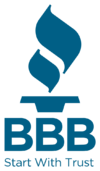Better Business Bureau facts for kids
 |
|
| Founded | 1912 |
|---|---|
| Type | 501(c)(6) non-profit organization |
| Focus | Consumer education Industry self-regulation |
| Headquarters | 4250 N Fairfax Drive, Suite 600 Arlington, Virginia U.S. 22203 |
|
Area served
|
United States and Canada |
| Products | BBB Business Reviews Accreditation for businesses Dispute resolution services |
| Services | Rating site |
| Subsidiaries | BBB Wise Giving Alliance |
|
Revenue
|
$215 million |
| Expenses | $20 million |
|
Employees
|
2,500 |
The Better Business Bureau (BBB) is a private, non-profit organization. It was started in 1912 in the United States. The BBB's main goal is to help people and businesses trust each other in the marketplace. It has 92 local offices across the United States and Canada. These offices work together under the International Association of Better Business Bureaus (IABBB). The main office is in Arlington, Virginia.
The Better Business Bureau is not part of the government. Businesses that join the BBB agree to follow its rules. This helps them manage themselves. The BBB does not recommend any specific business or product. This helps them stay fair.
The BBB uses a letter-grade system to rate businesses. Grades go from A+ to F. These grades show how much the BBB trusts a business. They also show how well a business handles customer problems. You can find out more about their ratings on their website. BBB staff look at how a business acts when they give it a rating.
As of July 2022, almost 400,000 businesses in North America were approved by the BBB. Businesses that want to be approved pay a fee. They also promise to follow the BBB Code of Business Practices. In return, approved businesses can use the BBB logo in their advertising.
Contents
How the BBB Started
Early Days (1906–1912)
The idea for the Better Business Bureau began around 1906. At that time, people started to worry about misleading advertising. Groups called "vigilance committees" formed across the U.S. by 1912. These groups watched out for unfair business practices. People like Samuel Candler Dobbs helped push for honest advertising.
How the BBB Works
Structure and Funding
The Better Business Bureau is a private, non-profit group. It works across the United States and Canada. Each local BBB office is separate. However, the International Association of Better Business Bureaus (IABBB) sets the rules for all of them. The IABBB also checks that the rules are followed.
The BBB gets most of its money from businesses that pay to be approved. Some people worry this might cause a conflict of interest. This is because business owners are often on the local BBB boards.
Helping Solve Problems
The BBB helps people and businesses solve disagreements. They offer different ways to do this. These include talking things out, mediation, and arbitration.
When someone files a complaint, the BBB sends it to the business. The business is asked to reply within 14 days. If there is no reply, the BBB follows up. Most cases are finished within about 30 days. They are marked as "resolved," "answered," "unanswered," or "unresolved."
The BBB does not have legal power. It helps people talk and find solutions. It does not make legal decisions.
Business Ratings and Approval
Understanding BBB Ratings
In 2009, the BBB started using a letter-grade rating system. This system goes from A+ to F. Before that, they used a Satisfactory/Unsatisfactory system. The new ratings are based on several things. These include how a business handles complaints and how transparent it is. They also look at how long a business has been around.
At first, being an approved business added points to a company's rating. However, after some concerns were raised in 2010, the BBB changed this. People worried that businesses might get higher grades just by paying fees. The BBB then removed approval status from the points system. They also promised to make improvements.
BBB in Canada
Joining US and Canadian Operations
On August 16, 2011, the BBB combined its U.S. and Canadian operations. This created one system for North America. The goal was to make it easier to handle complaints across borders. It also aimed to improve how businesses get approved.
Changes to Canadian Offices
In 2012, the International Association of Better Business Bureaus took away the right to use the BBB name from four Canadian offices. These were in Hamilton, Windsor, Montreal, and St. John's. This happened because they did not meet the BBB's standards. These offices either changed their names or joined other regional offices. By 2022, all Canadian areas are served by standard local offices. These offices follow the same rules.
See also
 In Spanish: Better Business Bureau para niños
In Spanish: Better Business Bureau para niños
- Angie's List
- ConsumerAffairs
- ResellerRatings
- Sitejabber
- Trustpilot

